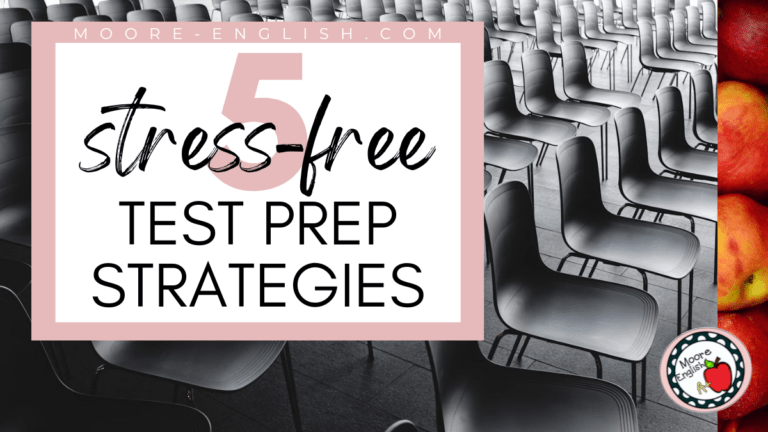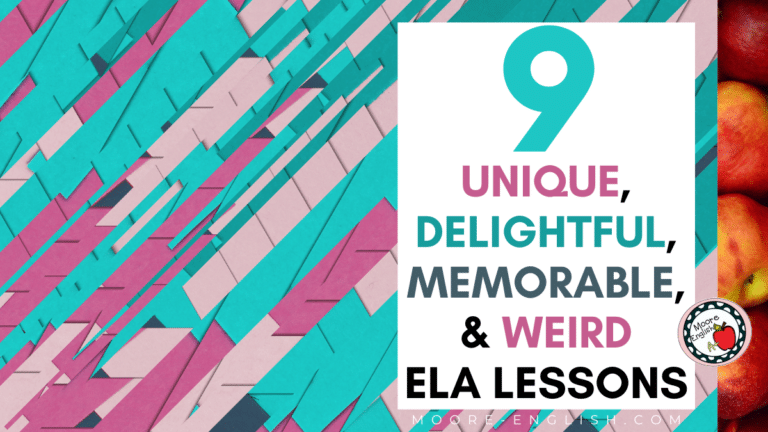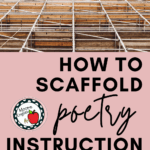I know that teaching poetry is not every ELA teacher’s forte, but it’s my teacher superpower! Over the years, I’ve refined the process to scaffold poetry instruction.
When I’m introducing poetry the first time, I start with a couple questions:
- Firstly, what have students previously learned about how to read a poem?
- Then, what topics, subjects, or content would engage students, even those reluctant to read poetry?
- Similarly, what is the optimum reading level for this lesson? At what level will students be successful?
- Finally, what is the goal of the lesson–to introduce poetry, to work on analyzing theme, or to build other analytical skills?
Once I have answers to these questions, especially the last one, I know where to start. In general, my process for how to scaffold poetry instruction looks like this:
- First, I start with the desired results or where students should be at the end of the unit.
- Then, I begin to think about how many lessons students will need to arrive at this point.
- Next, I evaluate the reading level on any assessments at the end of the unit.
- From there, I choose a spiral of poems that move from least to most complex, spiraling students up to or a little beyond the level they will see on any assessments.
- Finally, I choose a place to begin. Where or how will students enter in this unit?
This post this post may contain affiliate links. Please read the Terms of Use.
Begin by Ending Poetry Intimidation
Oftentimes, students’ greatest struggle with poetry is a sense of intimidation. For this reason, it’s important to help students get comfortable with poetry. To do this, the first thing I teach my students is how to pre-read poetry. Pre-reading is a great place to start to scaffold poetry instruction because it’s an immediate win for every student!
First, students number the lines of the poem. When students ask me why they have to do this, I turn that question back around and ask: “What’s the advantage of numbering the lines?” Pretty quickly students explain that numbering the lines puts everyone on the same page. When we begin writing about poetry, students learn that this little habit also makes it easier to provide citations.
Second, students label the rhyme scheme. This is where the question “What have students previously learned about how to read a poem?” becomes particularly important. Very rarely do my students arrive with any understanding of rhyme scheme. However, when students can identify rhyme scheme, they can often predict a poem’s turn.
Third, students circle meaningful punctuation, which I tell my students does not include commas. When students take note of dashes, question marks, and periods, they have a good chance of identifying the poem’s turn.
Finally, students make a prediction about the poem based on the title. I started to include this in our pre-reading because I found students sometimes ignored or overlooked the title.
Throughout the year, we might add a few more steps to our pre-reading. These steps might include:
- circling text features
- noting the point of view
- identifying any tense changes
As with other pre-reading steps, these three can help students get to know the poem before they actually begin reading.
To make this as effective as possible, grab my pre-reading anchor charts!
Spiral, Spiral, Spiral to Scaffold Poetry Instruction
Overall, to scaffold poetry instruction, it’s important to choose a strong text spiral. It’s not so much about how many poems students read, but it’s important that students move through a series of texts with increasing rigor.
To increase rigor, teachers can choose progressively more challenging and complex texts. Additionally, teachers can increase rigor by asking students to do more and more of the work independently.
My favorite (and most tried-and-true) poetry spiral only uses four poems. I use this instructional spiral with my sophomores, and I have some options for adding more support as needed.
Start with Modeling
First, I start with a poem that is engaging but not threatening. Over the years, I’ve had great luck with “Long Distance II” by Tony Harrison. On the surface, this poem about death, grieving, and loss doesn’t seem like high-school-student fare. However, the speaker’s vulnerability and earnestness always seem to resonate.
With “Long Distance II,” I model the 4 Steps for Pre-Reading Poetry. As we read the poem, I use a gradual release strategy with each step in the process. For example, I label the rhyme scheme in stanza one. Then, we label stanza two together before students try stanzas three and four on their own. But stanza four is where the fun begins because the rhyme scheme changes! Read the poem here.
Raise the Rigor
Because the language in “Long Distance II” is fairly straightforward, it usually only takes one class period. In the next class period, students use their skills to level up as we move to “Invictus” by William Ernest Henley.
“Invictus” is a more challenging poem because of its language and the allusions it makes. By this point, students move through the 4 Steps for Pre-Reading a Poem with their elbow partner. Then, we compare answers as a class to make sure we’re all on the same page.
On the surface, it seems odd to pair “Long Distance II” and “Invictus.” However, both poems have similar structures and make similar changes in rhyme scheme. In other words, the first poem prepares students for the second. Additionally, students usually have a great conversation about how both poems touch on courage.
Continue to Raise the Rigor
To scaffold poetry instruction, it’s important to help students continue progressing in baby steps. Between the first two texts, students moved from plain to more complex language. For the third text in this instructional spiral, I use “Courage” by Anne Sexton. This time, I’m changing the form and structure of the poem while backing down a little on the language.
In “Courage,” Sexton uses free verse split across four symbolic stanzas. For the most part, the language is more modern (although “comver” throws students every time). While rhyme is not a factor in this poem, this text requires students to make inferences about the speaker.
For this poem, we return to the gradual release strategy but speed things up. First, we read and annotate the stanza one together. Then, students read and annotate stanza two with their elbow partner before reading and annotating three and four independently.
Over the years, “Courage” has become a poem students remember all year long. This poem pairs beautifully with “Invictus,” and students have a conversation about different versions of courage. Both of these texts are included in my Courage Synthesis Bundle!
To Scaffold Poetry Instruction, Release Control
As students become more confident with their ability to interact with poetry, I challenge them with an excerpt from “Ulysses” by Alfred, Lord Tennyson. To make this poem a little more manageable, I usually only teach half of the last stanza (from “Come…”).
Since this is often the last poem students read before an assessment, I send the last stanza home with students and ask them to complete the pre-reading and first two reads independently.
When students return to class, they are usually frustrated with this text, so students start class by sharing their annotations and questions with their elbow partners.
What students don’t know is that this text is more challenging than anything they’ll find on an assessment, so when they conquer this text, they feel confident going forward!
Ultimately, one of the things I love about teaching “Ulysses” is that it resonates so well with the other texts in this spiral! While all of the poems deal with courage, they all also touch on the idea of aging. These connections allow students to synthesize across texts!
And that leads me to the last element in how to scaffold poetry instruction: it helps if all the texts connect to one another! If you can select texts that relate to one another, students will be more engaged, take greater meaning from the exercise, and, ultimately, be more successful! For this reason, I have put together several synthesis bundles to spiral instruction:
- Protest Poetry and Literature
- Synthesizing with Mythology
- Statue of Liberty Bundle
- Animal Symbolism
- Love Poems
- War Poems
Teaching Poetry Continued
Since poetry is one of my favorite subjects to teach, I’ve written about it quite a bit. Check out additional poets about teaching poetry!
- How Not to Kill a Love of Poetry
- 5 Creative Lessons for Teachers that Hate Poetry
- Make the Most of Poetry Instruction by Teaching Meter
- 5 Lessons to Make the Most of Poetry in the Classroom













